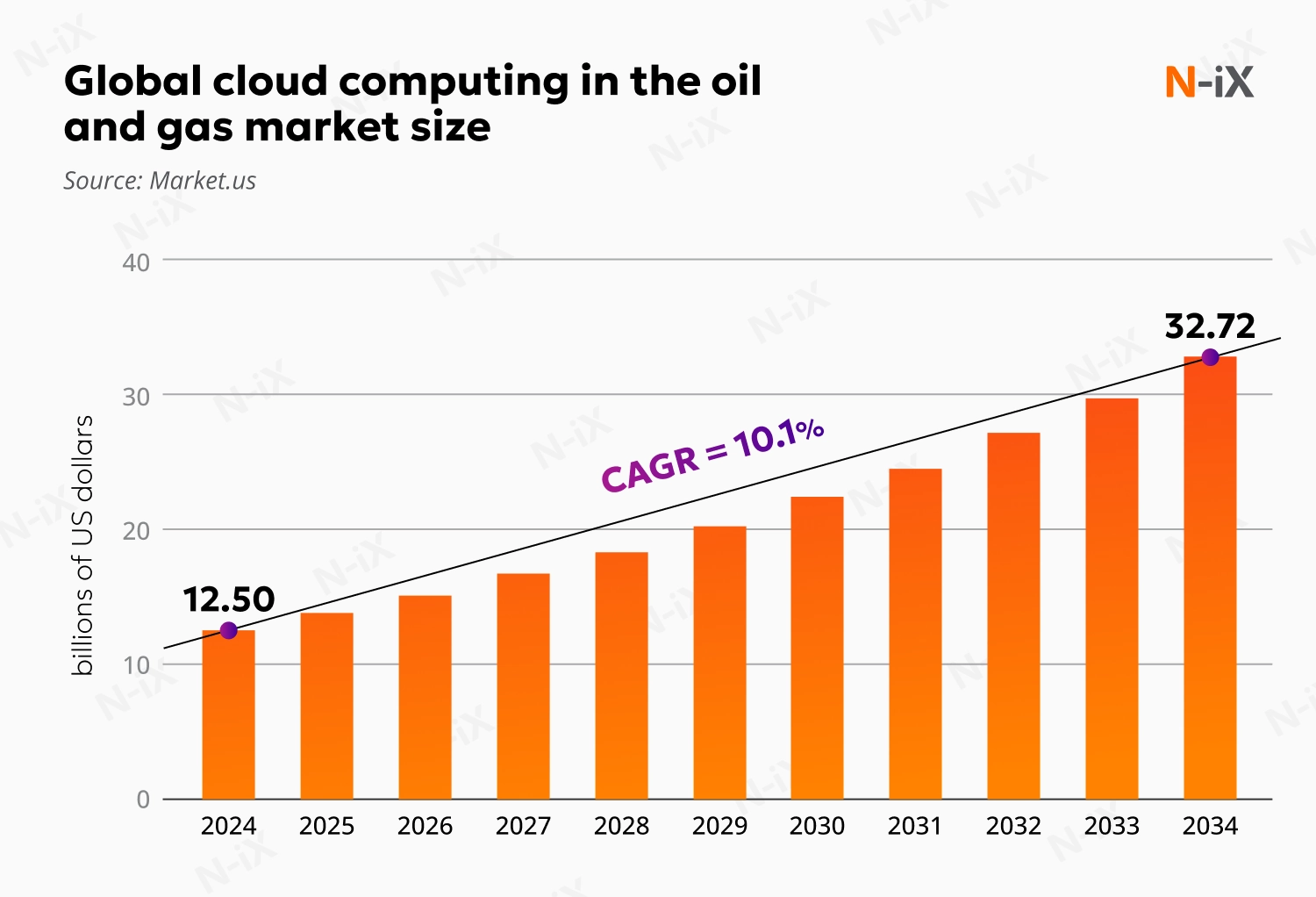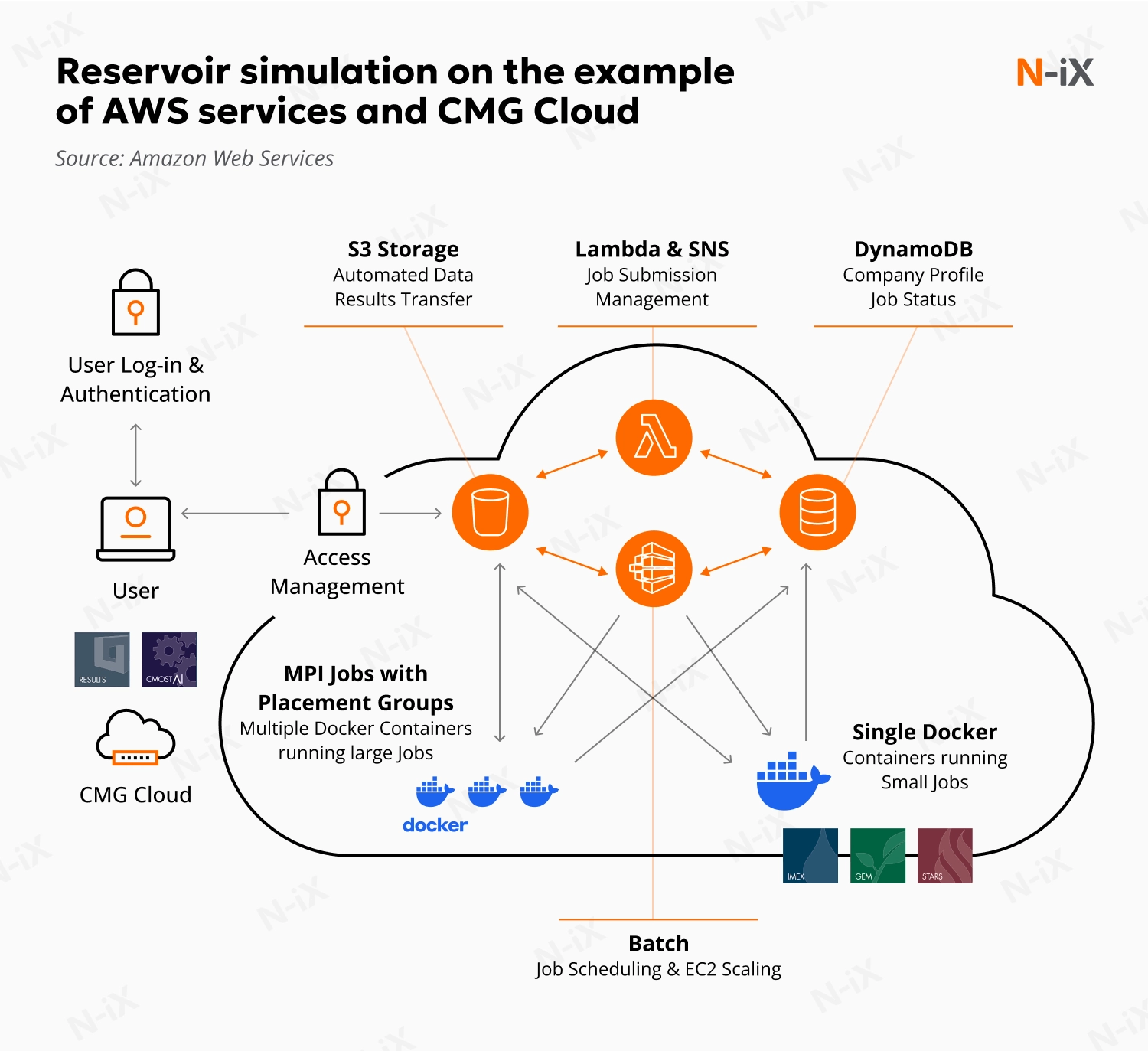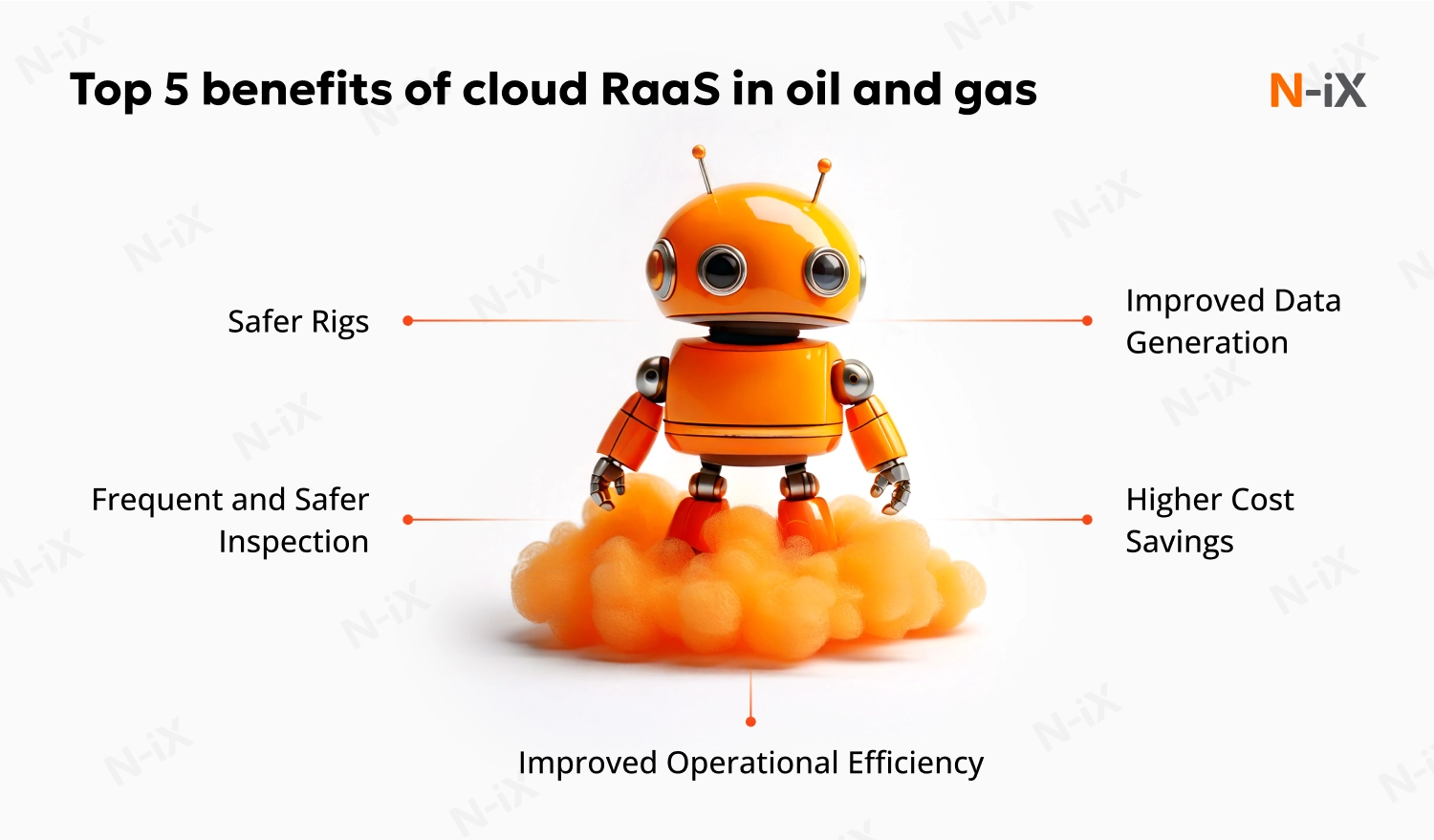Cloud services and solutions allow oil and gas businesses to address numerous challenges, like reducing costs, automating pipelines, and streamlining product delivery. According to the Market.us report, the global cloud computing market in the oil and gas industry will reach $32.72B by 2034, up from $12.5B in 2024, growing at a CAGR of 10.1%. But what specific applications are driving this shift, and how do they create value? We gathered the main benefits and use cases of cloud computing for oil and gas to help you discover.

Top 7 cloud applications for oil and gas
Cloud solutions help companies address specific operational challenges while offering opportunities that were not previously possible with traditional infrastructure. N-iX engineers shared the main use cases of cloud adoption in the oil and gas industry:
1. Streamlined exploration and delivery
Cloud technology in oil and gas enables the processing of the massive geological datasets required for exploration activities. Businesses can analyze seismic and geological information faster, identifying potential drilling sites with improved accuracy. This capability leads to more efficient exploration processes and substantial cost reductions.
Geoscientists can now process complex calculations that would otherwise require extensive on-premises computing resources. Our cloud engineers recommend leveraging scalable cloud infrastructure to eliminate these bottlenecks, enabling advanced geological analysis without the major capital investments.
2. Reservoir management
Companies can integrate and analyze vast amounts of geological and seismic data to develop real-time reservoir models, leveraging the transformative potential of cloud computing in the oil and gas sector. These models allow geoscientists to simulate different extraction scenarios, optimize drilling strategies, and enhance oil recovery rates with unprecedented accuracy.
Cloud simulation platforms provide scalable computing power for reservoir modeling without requiring extensive infrastructure investments. This approach enables more frequent model updates and scenario testing.
3. Advanced simulation and modeling
The oil and gas sector has traditionally required immense computing power, leading many businesses to invest in expensive supercomputers. Cloud technology now provides access to this processing capability without the associated hardware and maintenance requirements. Adopting scalable, on-demand computational resources enables detailed simulations, assessing operational risks, and enhancing planning efficiency.

4. Supply chain optimization
Cloud computing allows oil and gas firms to track and manage materials, equipment, and inventory across global operations, optimizing supply chain operations. This ensures that the necessary equipment, data, or other critical resources are accessible at the right time and place. Such visibility allows for minimizing delays, streamlining procurement processes, and boosting overall supply chain efficiency across upstream and downstream operations. Cloud-based supply chain platforms can also help enhance unified visibility across the organizations as they connect planning, scheduling, assay, and distribution processes.
Learn more: Embracing cloud computing for travel industry: A comprehensive guide
5. Remote monitoring
Cloud-based systems enable continuous monitoring of delivery processes across multiple wells and facilities. Automated systems can adjust production parameters in real-time, accounting for reservoir conditions, market changes, and equipment performance.
Cloud monitoring solutions allow tracking of critical data from any location, reducing the need for on-site visits while improving safety and efficiency. Leveraging this capability also supports offshore operations and remote facilities.
6. IoT integration
IoT devices are widely used in the industry for monitoring equipment performance, environmental conditions, and operational parameters. The cloud infrastructure helps process the data generated by these devices and enables real-time monitoring and control capabilities.
IoT sensors on downhole wells, pumps, tanks, and meters collect data autonomously and store it in centralized cloud platforms. The collaboration of IoT and cloud computing for oil and gas enables various functions, such as monitoring pipeline integrity and tracking environmental conditions. This helps cloud engineers create a responsive operational ecosystem that enhances decision-making and efficiency.
Explore 6 disruptive IoT trends for 2026 and beyond—get the guide!


Success!

7. Robots-as-a-Service
Cloud computing is driving the growth of robots as a service (RaaS), allowing companies to access and deploy robotic solutions for inspection, maintenance, and dangerous tasks using flexible cloud platforms. RaaS includes advanced equipment, training, technical support, repairs, and software upgrades. This enables oil and gas companies to utilize robotic solutions for tasks like pipeline inspection or offshore platform maintenance, minimizing human exposure to dangerous conditions.

Read more: Cloud computing in telecom: stats, benefits, best practices
How can the oil and gas industry benefit from cloud adoption?
Adopting the cloud in oil and gas empowers companies to optimize operations, increase efficiency, and reduce costs. Here are some of the most significant advantages:
Enhanced automation
Cloud computing enables automation in the oil and gas industry by replacing time-consuming manual processes with automated workflows. Tasks such as data entry, report generation, and resource allocation can be managed by cloud-based systems, reducing dependence on human intervention. This automation accelerates operations, minimizes errors, and ensures consistency across processes. As a result, companies can achieve higher productivity and reduce the time needed for routine operations.
Improved collaboration
Oil and gas activities usually span remote drilling sites, production facilities, and corporate offices, and coordinating them across diverse locations becomes challenging. Cloud computing resolves this issue by allowing teams to share real-time updates, plans, and performance metrics through unified interfaces. Cloud-based collaboration tools streamline documentation, compliance reporting, and decision-making by promoting transparency across departments.
Cost reduction
High capital and operational expenses are a major concern for oil and gas companies. Leveraging cloud for oil and gas helps reduce expenses by minimizing the need for significant investments in physical infrastructure, such as on-site servers and data storage facilities. Its pay-as-you-go model allows firms to pay only for the resources they use, redirecting funds to critical business activities while avoiding the costs of maintaining and upgrading hardware.
Streamlined data management
Cloud computing in the oil and gas industry streamlines data management by allowing for centralized storage, streamlined organization, and real-time accessibility. Petroleum firms generate vast volumes of data from seismic surveys, drilling logs, and production metrics. Cloud solutions ensure that this critical information is readily available for analysis and reporting, helping reduce data silos. As a result, teams can make well-informed decisions without delays caused by inaccessible or disorganized datasets.
Lower downtime
Cloud computing for oil and gas helps lower downtime by enabling real-time monitoring and predictive analytics to identify potential issues before they escalate. By proactively addressing equipment maintenance or operational risks through cloud-based insights, companies can ensure continuous production, minimize interruptions, and ensure sustained profitability.
Enhanced scalability and flexibility
The industry experiences fluctuating workloads, with intense computational needs during exploration phases and reduced demand during off-peak periods. Cloud solutions for oil and gas offer adaptability and scalability, enabling businesses to adjust resources according to their immediate needs. This ensures access to additional processing power when needed, while minimizing costs during quieter times.
Lower carbon footprint
Environmental sustainability is increasingly critical in the oil and gas industry, with pressure to reduce carbon emissions. Cloud computing contributes to a lower carbon footprint by minimizing the reliance on energy-intensive on-site data centers. Optimizing resource use and supporting remote operations enables companies to align with sustainability goals, decrease energy consumption, and demonstrate environmental responsibility to stakeholders and regulators.
Why choose N-iX to adopt cloud computing for oil and gas?
Implementing cloud computing in oil and gas requires extensive expertise and proven capabilities. Partnering with an experienced cloud consultant can fulfill these needs. For example, collaborating with N-iX cloud engineers gives you access to their professional skills and deep industry experience.
N-iX is a global software solutions and engineering services company with the technical expertise to address complex industry challenges and deliver lasting business value. With 23 years of experience in the international market, N-iX supports organizations across various industries, including the oil and gas sector. Backed by a team of over 400 cloud experts, N-iX partners with the leading cloud providers and is an AWS Premier Tier Services Partner, Google Cloud Platform Partner, and Microsoft Solutions Partner.
We successfully delivered over 150 cloud projects during the last 5 years and helped businesses leverage innovation and progress. Our flexible engagement model allows us to customize cloud solutions to your unique business requirements.
Have a question?
Speak to an expert




